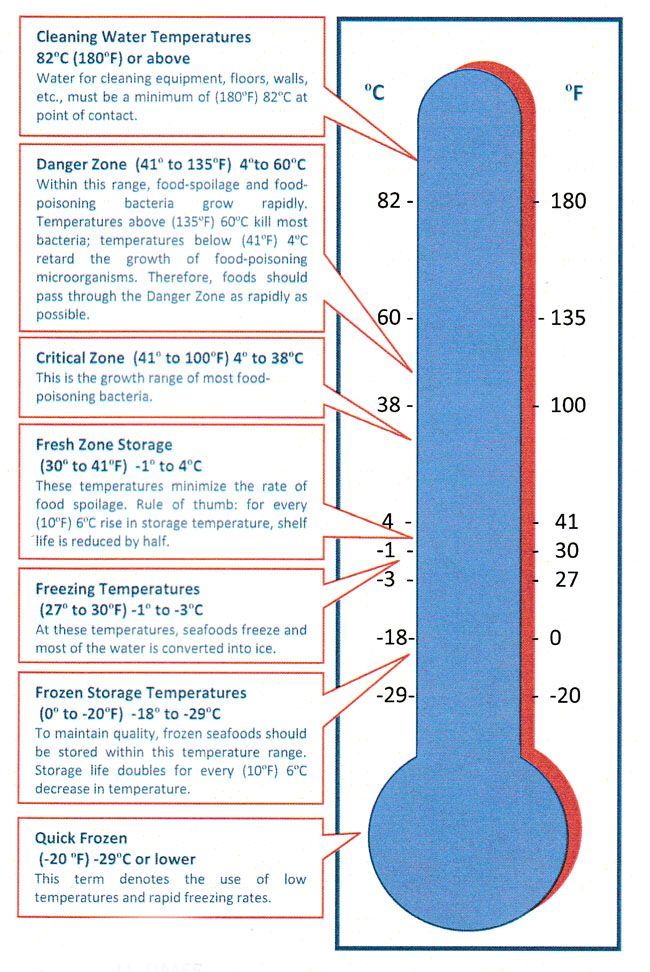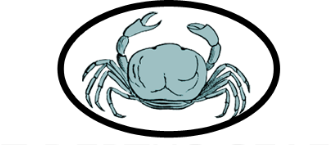CARE & HANDELING
Fresh Fish & Seafood
FRESH FISH & SEAFOOD
DO NOT WAIT TO PUT AWAY YOUR FISH
DO IT NOW
The fish you have accepted is the finest quality and must be kept that way until consumed. Immediately place in a low temperature storage area. 32 degrees F is the ideal temperature to retard spoilage and retain freshness.
________________________________________________________
FRESH FISH CARE
1. Retard spoilage by keeping fish in a 32 degree F room on ice. Do not let the fish come in direct contact with the ice. Lay the fillets out flat in a covered container and separate the layers with plastic wrap or the like.
2. Do not store fish in water. Water will bleach out the color and nutrients from it. Spoilage is a certainty.
3. Ice must be allowed to drain off. Make sure your fish pans have holes in the bottoms to allow for their drainage.
4. Adhere to a strict rotation system (First in first out FIFO) to guard against spoilage and waste. Fresh fish and shell fish retain good quality for a limited time even with the best of care.
5. Ice down the fish everyday as needed. Important for over night storage.
6. Take only what you are going to cook into the hot kitchen during busy times. DO NOT allow fish to be in a hot area at all. A Styrofoam box or cooler full of ice can keep fish in a hot kitchen cool and handy.
7. One person should be responsible for the care of the fresh fish.
________________________________________________________
DEFROST AND HANDLING
Defrost in the refrigerator, microwave, or in a plastic bag in a pan of cool water. DEFROSTING AT ROOM TEMPERATURE PROMOTES HARMFUL BACTERIA.
Use separate plate for raw and cooked seafood, do not cross contaminate.
Fresh Fish & Seafood
COOKING
Rinse seafood in cold water for several seconds to remove any surface bacteria.
Always marinate seafood in the refrigerator, never on the counter.
Never use the same marinade for basting seafood.
Cook fish at 450 degrees for 10 minutes for each 1” of thickness, measured at thickest part of fillet.
Fish is done when flesh is opaque and begins to flake when tested with a fork.
Ask Ed & Mel for special cooking instructions pertaining to specialty seafood items.
________________________________________________________
LIVE LOBSTER CARE
Live lobster should be kept in the cooler in the container they arrive in. Keep them covered. Do not store in water unless you have a live tank with a salt water environment.
________________________________________________________
CLAM AND OYSTER CARE
Clams and oysters in the shell should be alive when purchased. Gaping shells that will not close when handled are dead and should be discarded immediately. Store in a cool damp atmosphere at about 35 degrees F. Do not store in ice or water as they will die. Properly refrigerated they will stay alive for several days.
________________________________________________________
MUSSELS
(handling tips)
Ice heavy and punch holes in container to allow water to drain out.
Do not over wrap with plastic. They must breathe.
Mussels naturally gape. When you see this, ice down and agitate. Gapers should close, if not-discard.
SEAFOOD HANDLER'S
THERMOMETER

